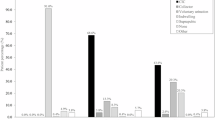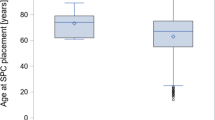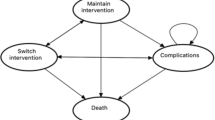Abstract
Study design:
Prospective, cross-sectional study, based on cases of spinal cord injury (SCI).
Setting:
Three outpatient medical departments in Seoul, Korea.
Objectives:
To assess depressive symptoms in patients on clean intermittent catheterization after SCI.
Methods:
In total, 102 subjects (68 males and 34 females, mean age 39.5 with a range of 18–75 years) were included in the primary analysis. A control group of 110 was selected from the routine health checkup. All subjects completed the Beck Depression Inventory (BDI).
Results:
For patients and controls, the average total BDI scores were 20.3±1.0 and 11.4±0.5, respectively (P<0.001). With regard to severity of depression among patient groups, three (3.0%) reported normal; four (3.9%) reported mild to moderate depression; 24 (23.5%) reported moderate to severe depression; and 71 (69.6%) reported severe depression. On the multivariate logistic regression analysis, a positive association with the risk of depression was observed in gender and type of catheterization. Female patients had a 3.8-fold higher risk (odds ratio (OR) 13.83; 95% confidence interval (CI) 1.42–10.31; P=0.008) of depression than male patients. In the same model, patients who were unable to perform catheterization independently had a 4.6-fold higher risk (OR 4.62; 95% CI 1.67–12.81, P=0.003) of depression than those who were able to perform self-catheterization.
Conclusions:
The results demonstrate that the patients with neurogenic bladder secondary to SCI have higher degrees of depression than normal population. In addition, our findings also suggest that depression is closely related to gender and patient's ability to perform self-catheterization.
Similar content being viewed by others
Log in or create a free account to read this content
Gain free access to this article, as well as selected content from this journal and more on nature.com
or
References
Krause JS, Kemp B, Coker J . Depression after spinal cord injury: relation to gender, ethnicity, aging, and socioeconomic indicators. Arch Phys Med Rehab 2000; 81: 1099–1109.
Kennedy P, Rogers BA . Anxiety and depression after spinal cord injury: a longitudinal analysis. Arch Phys Med Rehab 2000; 81: 932–937.
Beck AT, Ward CH, Mendelson M, Mock J, Erbaugh J . An inventory for measuring depression. Arch Gen Psychiatr 1961; 4: 561–571.
Hahn HM, Yun TH, Shin YW, Kim KH, Yoon DJ, Chung KJ . A standardization study of Beck Depression Inventory in Korea. J Korean Neuropsychiatr Assoc 1986; 25: 487–502.
Kim O . The relationship of depression to health risk behaviors and health perceptions in Korean college students. Adolescence 2002; 37: 575–583.
Kim O . Sex difference in social support, loneliness, and depression among Korean college students. Psychol Rep 2001; 88: 521–526.
Ku JH, Jeon YS, Kim ME, Lee NK, Park YH . Psychological problems in young men with chronic prostatitis-like symptoms. Scand J Urol Nephrol 2002; 36: 296–301.
Benevento BT, Sipski ML . Neurogenic bladder, neurogenic bowel, and sexual dysfunction in people with spinal cord injury. Phy Ther 2002; 82: 601–612.
Judd LL, Paulus MP, Wells KB, Rapaport MH . Socioeconomic burden of subsyndromal depressive symptoms and major depression in a sample of the general population. Am J Psychiatry 1996; 153: 1411–1417.
Jacob K, Zachariah K, Bhattahcharji S . Depression in spinal cord injury: methodological issues. Paraplegia 1995; 33: 377–380.
Frank RG, Elliott TR, Corcoran JR, Wonderlich SA . Depression after spinal cord injury: is it necessary? Clin Psychol Rev 1987; 7: 611–630.
Kendall PC, Hollon SD, Beck AT, Hammer CL, Ingram RE . Issues and recommendations regarding use of the Beck Depression Inventory. Cog ther Res 1987; 11: 289–299.
Blumenfield M, Schoeps MM . Psychological Care of the Burn and Trauma Patients. Williams and Wilkins: Baltimore 1993, pp 1–147.
Elliott TR, Frank RG . Depression following spinal cord injury. Arch Phys Med Rehab 1996; 77: 816–823.
Craig AR, Hancock KM, Dickson HG . Spinal cord injury: a search for determinants of depression two years after the event. Br J Clin Psychol 1994; 33: 221–230.
Frank RG et al. Dysphoria: a major symptom factor in persons with disability or chronic illness. Psychiatry Res 1992; 43: 231–241.
Fuhrer MJ, Rintala DH, Hart KA, Clearman R, Young ME . Depressive symptomatology in persons with spinal cord injury who reside in the community. Arch Phys Med Rehab 1993; 74: 255–260.
Malec J, Neimeyer R . Psychologic prediction of duration of inpatient spinal cord injury rehabilitation and performance of self-care. Arch Phys Med Rehab 1983; 64: 359–363.
Umlauf RL, Frank RG . Cluster analysis, depression, and ADL status. Rehab Psychol 1987; 32: 39–44.
Tate DG, Forchheimer M, Maynard F, Dijkers M . Predicting depression and psychological distress in persons with spinal cord injury based on indicators if handicap. Am J Phys Med Rehab 1994; 73: 175–183.
Krause JS, Sternberg M . Aging and adjustment after spinal cord injury: the roles of chronological age, time since injury, and environmental change. Rehab Psychol 1997; 42: 287–303.
Kerr WG, Thompson MA . Acceptance of disability of sudden onset in paraplegia. Paraplegia 1972; 10: 94–102.
Cook DW . Psychological adjustment to spinal cord injury: incidence of denial, depression and anxiety. Rehab Psychol 1979; 26: 97–104.
Furlan JC, Krassioukov AV, Fehlings MG . The effects of gender on clinical and neurological outcomes after acute cervical spinal cord injury. J Neurotrauma 2005; 22: 368–381.
Author information
Authors and Affiliations
Rights and permissions
About this article
Cite this article
Oh, SJ., Shin, HI., Paik, NJ. et al. Depressive symptoms of patients using clean intermittent catheterization for neurogenic bladder secondary to spinal cord injury. Spinal Cord 44, 757–762 (2006). https://doi.org/10.1038/sj.sc.3101903
Published:
Issue date:
DOI: https://doi.org/10.1038/sj.sc.3101903
Keywords
This article is cited by
-
Psychosocial Factors in Neurogenic Lower Urinary Tract Dysfunction: Implications for Multidisciplinary Care
Current Bladder Dysfunction Reports (2022)
-
Anxiety Levels and Sexual Functions of Patients Performing Clean Intermittent Catheterization
Sexuality and Disability (2021)
-
The use of mirabegron in neurogenic bladder: a systematic review
World Journal of Urology (2020)
-
Quality of Life and the Neurogenic Bladder: Does Bladder Management Technique Matter?
Current Bladder Dysfunction Reports (2017)
-
Frequency and age effects of secondary health conditions in individuals with spinal cord injury: a scoping review
Spinal Cord (2013)



